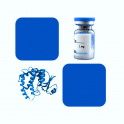
- Remove this product from my favorite's list.
- Add this product to my list of favorites.
Products
Newsletter
 |  |  |  |  |  |

Background
CD16 is a low affinity Fc receptor, and has been identified as Fc receptors FcγRIIIa (CD16a) and FcγRIIIb (CD16b). These receptors bind to the Fc portion of IgG antibodies. CD16 encoded by two different highly homologous genes in a cell type-specific manner.CD16 is found on the surface of natural killer cells, neutrophil polymorphonuclear leukocytes, monocytes and macrophages. CD16a antigen is also known as Low affinity immunoglobulin gamma Fc region receptor III-A, Fc-gamma RIII-alpha. CD16b is a low-affinity, GPI-linked receptor expressed by neutrophils and eosinophils, whereas CD16a is an intermediate affinity polypeptide-anchored transmembrane glycoprotein expressed natural killer cells, macrophages, subpopulation of T-cells, immature thymocytes and placentaltrophoblasts.CD16a is involved in phagocytosis, secretion of enzymes and inflammatory mediators, antibodydependent cytotoxicity and clearance of immune complexes. Aberrant expression or mutations of CD16a is implicated in susceptibility to recurrent viral infections, systemic lupus erythematosus, and alloimmune neonatal neutropenia.
Source
Recombinant Biotinylated Cynomolgus CD16, His,Avitag (FC6-C82E0) is expressed from human 293 cells (HEK293). It contains AA Gly 17 - Gln 208 (Accession # Q8SPW2-1).
Predicted N-terminus: Gly 17
Molecular Characterization
This protein carries a polyhistidine tag at the C-terminus, followed by an Avi tag (Avitag™).
The protein has a calculated MW of 25.7 kDa. The protein migrates as 36-45 kDa under reducing (R) condition (SDS-PAGE) due to glycosylation.
Biotinylation
Biotinylation of this product is performed using Avitag™ technology. Briefly, the single lysine residue in the Avitag is enzymatically labeled with biotin.
Biotin:Protein Ratio
Passed as determined by the HABA assay / binding ELISA.
Endotoxin
Less than 1.0 EU per μg by the LAL method.
Purity
>95% as determined by SDS-PAGE.
>90% as determined by SEC-MALS.
Formulation
Lyophilized from 0.22 μm filtered solution in PBS, pH7.4 with trehalose as protectant.
Reconstitution
Please see Certificate of Analysis for specific instructions.
For best performance, we strongly recommend you to follow the reconstitution protocol provided in the CoA.
Storage
For long term storage, the product should be stored at lyophilized state at -20°C or lower.
Please avoid repeated freeze-thaw cycles.
This product is stable after storage at:
-20°C to -70°C for 12 months in lyophilized state;
-70°C for 3 months under sterile conditions after reconstitution.
Bioactivity
Please refer to product data sheet.
(1) "Quantifying Antibody-Dependent Cellular Cytotoxicity in a Tumor Spheroid Model: Application for Drug Discovery"
Sturniolo, Váróczy, Bede et al
J Vis Exp (2024)
(2) "A specific natural killer cells phenotypic signature associated to long term elite control of HIV infection"
Rallón, Jiménez-Carretero, Restrepo et al
J Med Virol (2024) 96 (5), e29646
(3) "Phenotypic and functional characteristics of monocyte subsets in the blood and bone marrow of Indian subjects with Visceral Leishmaniasis"
Kausar, Chauhan, Roy et al
PLoS Negl Trop Dis (2024) 18 (4), e0012112
Showing 1-3 of 2732 papers.
Recombinant human Fc gamma RIIIB /CD16b Protein, His Tag (SPR & BLI & MALS verified), 100µg - 377,00 €
Recombinant Human FCGR3A / CD16a (F176) Protein, His Tag (SPR & BLI & MALS verified), 100µg - 377,00 €
Recombinant Human FCGR3A / CD16a (V176) Protein, His-Tag, 100µg - 377,00 €
Recombinant Biotinylated Human Fc gamma RIIIA / CD16a (F176), Avi Tag (Avitag™) , 25µg - 338,00 €
Follow us